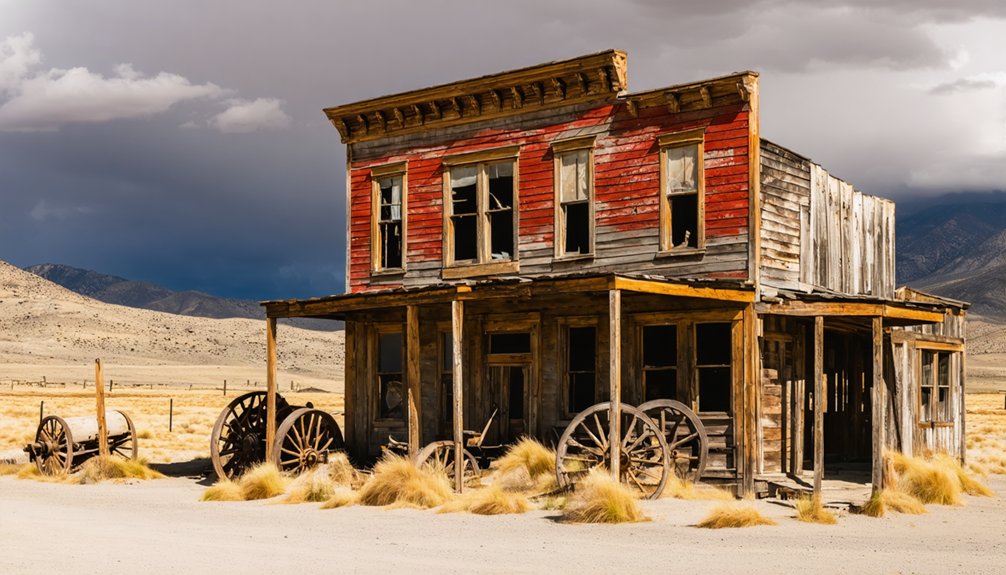Ghost towns emerge when communities face critical challenges that force residents to abandon their homes. You’ll find these settlements formed primarily through economic collapse (like when mines are depleted), natural disasters (floods, earthquakes), or shifting transportation routes that isolate towns. Environmental hazards, war, and demographic changes can also transform thriving communities into abandoned sites. Understanding these forces reveals deeper patterns in how human settlements rise, adapt, and sometimes fade away.
Key Takeaways
- Resource depletion leads to economic collapse when mines, oil fields, or other natural resources become exhausted or unprofitable to extract.
- Transportation network changes isolate communities when new highways bypass towns or railroad routes become obsolete.
- Natural disasters force permanent evacuations through sudden events like earthquakes or gradual environmental changes like rising sea levels.
- Population decline occurs as young people migrate to urban areas for better opportunities, leaving aging communities unsustainable.
- Military requisitions and political conflicts displace residents, sometimes permanently, transforming inhabited areas into abandoned settlements.
The Role of Resource Depletion in Town Abandonment
While ghost towns exist for various reasons, resource depletion stands as a primary driver of town abandonment throughout history.
You’ll find that many of these settlements began as bustling boomtowns centered around resource extraction of gold, silver, copper, coal, or other valuable minerals. When these natural resources became exhausted or unprofitable to mine, economic collapse quickly followed.
You can see this pattern in places like Bodie and Calico, California, where gold and silver veins ran dry in the early 1900s. In Russia, coal mine closures following the collapse of the Soviet Union turned numerous villages near Vorkuta into ghost towns.
Similarly, Kennicott, Alaska, emptied after its copper deposits were depleted by 1938, while Humberstone, Chile, died when synthetic fertilizers replaced natural nitrate mining.
These examples show how towns heavily dependent on single resources often faced swift, irreversible decline once their economic foundation disappeared. This was especially true in Thurman, West Virginia, where the shift to diesel locomotives caused the once-thriving railroad town to dwindle to just a handful of residents.
Natural Disasters and Community Displacement
Beyond resource depletion, natural disasters represent a powerful force in creating ghost towns worldwide.
You’ll find that disasters can displace entire communities through both sudden events like earthquakes and hurricanes, or gradual threats like rising sea levels and prolonged droughts. The statistics paint a stark picture – in 2020 alone, disasters forced over 30 million people from their homes, dwarfing conflict-related displacement. Weather-related hazards caused 17.2 million displacements in 2018 alone.
Poor disaster response and limited community resilience often determine whether a town recovers or becomes abandoned. The town of Villa Epecuén in Argentina stands as a prime example where flooding from a dam forced permanent evacuation.
When infrastructure damage exceeds local rebuilding capacity, or contamination makes areas uninhabitable – as seen in Chernobyl’s Pripyat – permanent evacuation becomes inevitable.
Most displaced populations gravitate toward urban centers offering better services and opportunities, leaving their original communities to decay into ghost towns.
Economic Forces Behind Ghost Town Formation
Although natural forces can create ghost towns, economic factors represent the primary driver behind community abandonment worldwide.
Sound economic reasons must exist for industries to locate in an area, and when those advantages disappear, decline follows.
You’ll find that resource dependency often leads to volatile boom-bust cycles, where towns rapidly expand around extractive industries like mining, only to collapse when resources deplete or become unprofitable.
The stark example of Bodie, California demonstrates how a thriving population of 10,000 residents can vanish when gold deposits run dry.
- Communities lacking economic diversification face the highest risk of abandonment
- Transient worker populations quickly leave when jobs disappear, accelerating decline
- Short-term infrastructure investment fails to create lasting community foundations
- Housing markets become unstable as speculation gives way to mass exodus
- Limited business agglomeration prevents sustainable economic activity
Without diverse economic opportunities, these single-industry towns can’t maintain their populations.
When the primary economic driver fails, you’ll see a swift chain reaction of job losses, outmigration, and infrastructure deterioration that transforms once-thriving communities into ghost towns.
Transportation Changes and Their Impact
Transportation networks shape the fate of communities, with changes in routes and technology directly influencing which towns thrive or fade into abandonment.
You’ll find this transportation evolution throughout American history, from riverboat towns dying when railroads arrived to railroad towns collapsing when bypassed by new rail routes or highways. Communities like Union Level, VA and Glenrio exemplify how economic isolation follows transportation shifts. The arrival of the Southern Railroad line brought a surge of commerce and development to Union Level in the early 1900s.
When interstates replaced older highways and rail lines closed, many towns lost their economic lifelines. By the start of the Civil War, over 30,000 miles of tracks connected American towns and cities across the nation.
You’re seeing the aftermath of this pattern in countless ghost towns across the country. The mechanization of transport combined with changing agricultural and industrial needs created a perfect storm – when towns lost their transportation access, they often lost their reason for existing, leading to inevitable depopulation.
War and Political Upheaval as Drivers
When conflicts and political upheaval sweep through regions, they leave abandoned towns in their wake as enduring scars of human displacement. War displacements can transform thriving communities into ghost towns through military requisitions, ethnic cleansing, and civil conflicts.
War leaves ghost towns as haunting monuments to displaced lives, transforming vibrant communities into empty shells through conflict and persecution.
You’ll find these haunting remnants scattered across continents, from Tyneham’s military takeover to Oradour-sur-Glane’s tragic massacre. During World War II, Tyneham residents were given one month to evacuate their village to accommodate military training needs. Some abandoned towns originated as royal residences that were forsaken during political turmoil.
- Towns like Kayaköy stand frozen in time after forced population exchanges
- Military training areas, such as Tyneham, remain unsafe due to unexploded ordnance
- Civil wars create widespread abandonment, as seen in South Sudan’s Lukangol
- Ethnic cleansing permanently alters regional demographics and erases communities
- Border changes and regime shifts can isolate towns until they’re completely deserted
These ghost towns serve as powerful reminders of how political decisions and conflicts can permanently alter human geography.
Environmental Catastrophes and Hazardous Sites
Throughout history, environmental catastrophes and hazardous conditions have transformed once-thriving communities into uninhabitable ghost towns.
You’ll find stark examples like Centralia, Pennsylvania, where an underground mine fire still burns, releasing toxic fumes that forced residents to abandon their homes.
Rising sea levels have claimed coastal communities like Burrwood, Louisiana, and Vunidogoloa, Fiji, while toxic contamination from industrial activities has rendered places like Picher, Oklahoma, and Wittenoom, Australia, dangerous to inhabit.
Environmental hazards from nuclear disasters, as seen in Namie, Fukushima, have created modern ghost towns, while volcanic activity buried Plymouth, Montserrat, under pyroclastic flows.
These abandoned settlements serve as sobering reminders of nature’s power and humanity’s industrial impact on previously vibrant communities.
Demographic Shifts and Population Loss

Modern population shifts herald a new era of ghost towns, driven by complex demographic changes rather than environmental catastrophes.
When you examine population sustainability across the United States, you’ll find nearly half of cities face projected losses of up to 23% by 2100, creating conditions ripe for abandonment.
Key demographic changes driving this transformation include:
- Fertility rates dropping below replacement levels worldwide
- Young people migrating to larger urban centers for better opportunities
- Aging populations creating unsustainable demographic imbalances
- Economic instability forcing residents to relocate
- Climate change pushing people away from less habitable regions
You’re witnessing a fundamental restructuring of human settlement patterns, where smaller communities struggle to maintain essential services as their populations dwindle.
This shift creates a self-reinforcing cycle: fewer residents mean less tax revenue, leading to deteriorating infrastructure and further exodus.
Infrastructure Development’s Unintended Effects
You’ll find numerous examples of once-thriving towns that became ghost towns when new highways diverted traffic and commerce away from their main streets.
The flooding of valleys for dam projects, like in France’s Tignes, has forced entire communities to relocate, leaving their original settlements submerged and forgotten.
Former railway hubs have also transformed into ghost towns as changing transportation technologies and economic patterns rendered their infrastructure obsolete.
Bypassed Towns Fall Silent
While infrastructure development aims to improve transportation efficiency, the construction of bypass routes has led to the unintended decline of countless small towns across the country.
The bypass impacts are particularly severe in communities with populations under 4,000, where economic stagnation takes hold as traffic-dependent businesses struggle to survive.
You’ll find these consequences most evident in:
- Reduced retail and service revenue from fewer passing travelers
- Loss of local employment opportunities, especially in hospitality sectors
- Weakened community bonds as social venues close their doors
- Declining population as residents seek opportunities elsewhere
- Diminished local identity when Main Street businesses shutter
These changes often create a domino effect, transforming once-vibrant communities into quiet shells of their former selves, particularly when combined with broader rural economic challenges.
Dam Projects Displace Communities
Despite their vital role in power generation and water management, large-scale dam projects have triggered one of history’s most extensive forced migrations, displacing an estimated 80 million people worldwide over the past century.
When you examine dam displacement cases, you’ll find that 82% of affected communities face severe deterioration in their living standards.
You’re looking at devastating losses – productive farmland submerged, livelihoods destroyed, and social networks shattered.
In Brazil alone, dam projects have flooded 3.4 million hectares and forced over 1 million people from their homes.
The impacts reach far beyond immediate displacement, affecting 472 million people downstream through disrupted ecosystems and altered water access.
While authorities often promise improved conditions through resettlement, community resilience is severely tested as displaced populations struggle with landlessness, unemployment, and fragmented social support systems.
Railway Hubs Gone Obsolete
Throughout the 20th century, fundamental shifts in transportation technology transformed America’s railway system from an essential economic lifeline into a network of obsolete infrastructure, creating waves of ghost towns in its wake.
Railway decline struck hardest at communities built around rail operations, where the combined impact of automotive transport, air travel, and containerized shipping eliminated thousands of jobs and critical economic activity.
You’ll find these stark effects of transportation technology evolution reflected in numerous communities:
- Loss of rail services triggered business closures and population exodus
- Shift to highways and airports diverted government investment from rail infrastructure
- Centralization of freight operations bypassed smaller railway towns
- Abandoned tracks and stations became symbols of economic stagnation
- Communities lost their tax base, leading to reduced services and accelerated decline
Physical Remnants and Historical Significance
You’ll find that ghost towns‘ structural remnants deteriorate at varying rates, with wooden buildings often succumbing first to weather and vandalism, while stone foundations and mining equipment prove more resilient.
These physical remains, from bottle-embedded walls to preserved schoolhouses, serve as tangible links to America’s frontier and industrial heritage.
The preservation of these sites as protected landmarks helps guarantee that future generations can study and understand the economic, social, and technological forces that shaped these once-thriving communities.
Structural Decay Over Time
When abandoned buildings succumb to the elements, their deterioration follows predictable patterns that reveal the interplay between materials, climate, and time.
You’ll witness the gradual loss of structural integrity as weather, wildlife, and human activity combine to accelerate material degradation.
- Wood rots and warps when moisture penetrates, inviting destructive fungi and insects
- Metal components corrode through constant exposure to rain and oxygen
- Masonry cracks from freeze-thaw cycles and invasive root systems
- Glass shatters from thermal stress and vandalism, exposing interiors
- Wildlife and vegetation steadily weaken structures from within
In arid regions, you’ll find buildings standing longer due to slower decay, while humid climates speed up deterioration through rot and mold.
The forces of nature reclaim these spaces methodically, transforming solid structures into haunting reminders of what once was.
Heritage Sites Worth Preserving
Many ghost towns deserve preservation status due to their irreplaceable role in documenting America’s industrial and cultural heritage.
You’ll find original structures like schools, churches, and mining facilities that showcase period-specific architecture, while artifacts inside these buildings provide authentic glimpses into past ways of life. These sites serve as outdoor museums, offering crucial educational opportunities about historical livelihoods and societal changes.
Through careful preservation efforts, you’re able to explore buildings maintained in “arrested decay,” preventing further deterioration while retaining their historic character.
This approach guarantees cultural continuity for future generations. Ghost towns connected to significant events, such as gold rushes or early state capitals, offer tangible evidence of settlement patterns and economic cycles that shaped America’s development.
Their preservation allows you to experience history firsthand.
Frequently Asked Questions
Can Ghost Towns Legally Be Purchased and Redeveloped for Modern Use?
Like floppy disks making a comeback, you can purchase ghost towns with clear property ownership, but you’ll face significant redevelopment challenges involving infrastructure, zoning laws, and historic preservation requirements.
How Do Ghost Towns Affect Property Values in Neighboring Communities?
You’ll see property market declines of 7-10% within 500 feet of ghost towns, as abandoned structures trigger a ripple effect, creating negative neighboring impact on home values and local economies.
Are There Ghost Towns That Have Successfully Revived Into Thriving Communities?
You’ll find successful ghost town revivals through various strategies, from Jerome, Arizona’s arts-focused transformation to Bellefontaine, Ohio’s private investments, where community engagement and cultural tourism drive their thriving resurrection.
What Roles Do Supernatural Beliefs Play in Keeping Ghost Towns Abandoned?
You’ll find supernatural folklore and hauntings impact ghost towns’ abandonment by deterring resettlement, as widespread beliefs in curses and spirits create psychological barriers that discourage people from reclaiming these spaces.
Do Governments Maintain Any Basic Services in Officially Designated Ghost Towns?
You’ll find minimal government services in ghost towns – mostly basic safety inspections and access regulations. Most lack utilities, though some get limited maintenance if they’re official historic sites or parks.
References
- https://westernmininghistory.com/664/what-is-a-ghost-town-wmh-town-classifications-explained/
- https://history.howstuffworks.com/history-vs-myth/ghost-towns.htm
- https://www.merriam-webster.com/dictionary/ghost town
- https://www.britannica.com/topic/ghost-town
- https://en.wikipedia.org/wiki/Ghost_town
- https://plainenglish.com/lingo/ghost-town/
- https://freepages.history.rootsweb.com/~gtusa/definitions.pdf
- https://exhibits.lib.utah.edu/s/ghost-towns/page/Introduction
- https://grokipedia.com/page/Ghost_Town
- https://www.youtube.com/watch?v=eyOASXxAmMI



